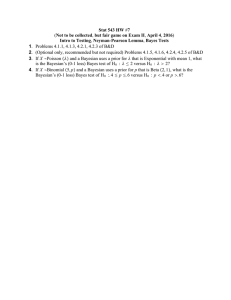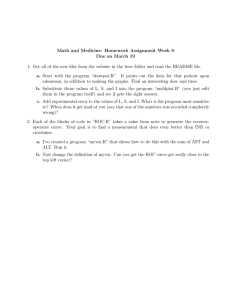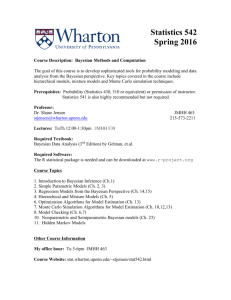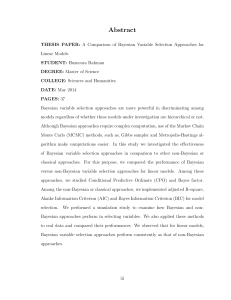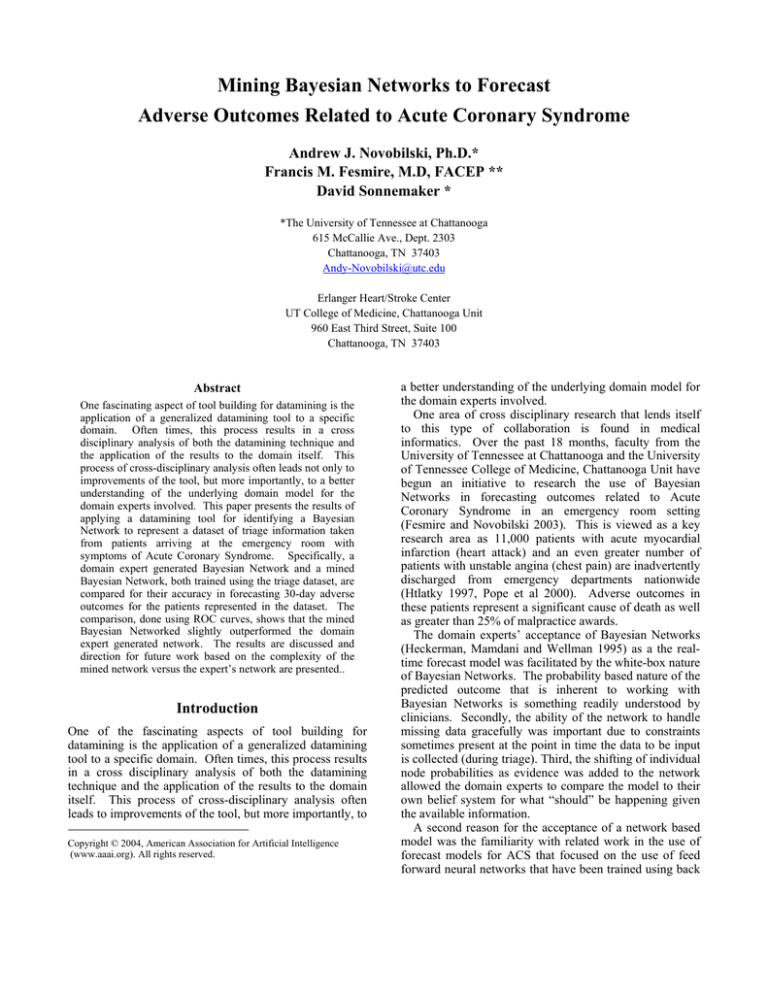
Mining Bayesian Networks to Forecast
Adverse Outcomes Related to Acute Coronary Syndrome
Andrew J. Novobilski, Ph.D.*
Francis M. Fesmire, M.D, FACEP **
David Sonnemaker *
*The University of Tennessee at Chattanooga
615 McCallie Ave., Dept. 2303
Chattanooga, TN 37403
Andy-Novobilski@utc.edu
Erlanger Heart/Stroke Center
UT College of Medicine, Chattanooga Unit
960 East Third Street, Suite 100
Chattanooga, TN 37403
Abstract
One fascinating aspect of tool building for datamining is the
application of a generalized datamining tool to a specific
domain. Often times, this process results in a cross
disciplinary analysis of both the datamining technique and
the application of the results to the domain itself. This
process of cross-disciplinary analysis often leads not only to
improvements of the tool, but more importantly, to a better
understanding of the underlying domain model for the
domain experts involved. This paper presents the results of
applying a datamining tool for identifying a Bayesian
Network to represent a dataset of triage information taken
from patients arriving at the emergency room with
symptoms of Acute Coronary Syndrome. Specifically, a
domain expert generated Bayesian Network and a mined
Bayesian Network, both trained using the triage dataset, are
compared for their accuracy in forecasting 30-day adverse
outcomes for the patients represented in the dataset. The
comparison, done using ROC curves, shows that the mined
Bayesian Networked slightly outperformed the domain
expert generated network. The results are discussed and
direction for future work based on the complexity of the
mined network versus the expert’s network are presented..
Introduction
One of the fascinating aspects of tool building for
datamining is the application of a generalized datamining
tool to a specific domain. Often times, this process results
in a cross disciplinary analysis of both the datamining
technique and the application of the results to the domain
itself. This process of cross-disciplinary analysis often
leads to improvements of the tool, but more importantly, to
Copyright © 2004, American Association for Artificial Intelligence
(www.aaai.org). All rights reserved.
a better understanding of the underlying domain model for
the domain experts involved.
One area of cross disciplinary research that lends itself
to this type of collaboration is found in medical
informatics. Over the past 18 months, faculty from the
University of Tennessee at Chattanooga and the University
of Tennessee College of Medicine, Chattanooga Unit have
begun an initiative to research the use of Bayesian
Networks in forecasting outcomes related to Acute
Coronary Syndrome in an emergency room setting
(Fesmire and Novobilski 2003). This is viewed as a key
research area as 11,000 patients with acute myocardial
infarction (heart attack) and an even greater number of
patients with unstable angina (chest pain) are inadvertently
discharged from emergency departments nationwide
(Htlatky 1997, Pope et al 2000). Adverse outcomes in
these patients represent a significant cause of death as well
as greater than 25% of malpractice awards.
The domain experts’ acceptance of Bayesian Networks
(Heckerman, Mamdani and Wellman 1995) as a the realtime forecast model was facilitated by the white-box nature
of Bayesian Networks. The probability based nature of the
predicted outcome that is inherent to working with
Bayesian Networks is something readily understood by
clinicians. Secondly, the ability of the network to handle
missing data gracefully was important due to constraints
sometimes present at the point in time the data to be input
is collected (during triage). Third, the shifting of individual
node probabilities as evidence was added to the network
allowed the domain experts to compare the model to their
own belief system for what “should” be happening given
the available information.
A second reason for the acceptance of a network based
model was the familiarity with related work in the use of
forecast models for ACS that focused on the use of feed
forward neural networks that have been trained using back
propagation (Ebell 1993). More recently, Baxt et al
reported on the ability of a neural network to identify heart
related problems in patients arriving at the emergency
department with chest pain (Baxt et al 2002). In 2,204
patients, the network had a true positive rate (sensitivity)
of 88% and a true negative rate (specificity) of 86% for
Acute Coronary Syndrome despite the fact that a mean of
5% of all required network input data and 41% of cardiac
marker data were missing (Baxt et al 2002). The authors
conclude that neural networks have the potential to be
utilized as a real time aid to identify the presence of AMI
and ACS.
Its important to note, however, the point in time at
which the data snapshot was taken. In the work done by
Baxt et al, forty variables were collected on patients that
included an Electrocardiograph (ECG) and blood work
necessary to check the first set of cardiac marker enzymes.
In contrast, the work being described in this paper focuses
on the real-time use of a forecast model where the data
presented to the model is that which has been collected
during triage. In fact, there is only one variable, the
physician’s classification of the chest pain being exhibited
by the patient, that is subjective in nature. The remainder
of the information collected consists of demographic and
prior history information that can be collected as soon as
the patient arrives at the emergency room, or even earlier if
Emergency Medical Technicians (EMTs) are dispatched to
the patient.
The remainder of this paper presents the initial effort by
the cross disciplinary team to establish the value of
applying a datamining tool to initial triage data to identify
a Bayesian Network capable of forecasting adverse
outcomes in patients arriving at the emergency room with
symptoms of Acute Coronary Syndrome.
This effort
resulted in the comparison of two Bayesian models; a
domain expert generated Bayesian Network and a mined
Bayesian Network. Both networks were trained using the
triage dataset, and then evaluated for their accuracy in
forecasting 30-day adverse outcomes for the patients
represented in the dataset. The evaluation, done using
ROC curves, allowed for a comparison that showed the
mined Bayesian Networked outperformed the domain
expert generated network. The results are discussed and
direction for future work based on the complexity of the
mined network versus the expert’s network are presented.
death within 30 days of their initial visit to the emergency
room.
Each record consisted of the fourteen clinical
variables shown in Table 1. This information was
obtained on initial patient triage and was restricted to
population demographics, classic risk factors, presence of
pre-existing ischemic heart disease, and the nature and
duration of chest pain.
The Domain of Interest
For the first part of the evaluation, a domain expert was
given a blank Netica (Netica 1997) screen and asked to
produce a “basic” model representing the interactions
between the variables in Table 1, and the variable of
interest, “ACS”, which represents 30-day Adverse
Outcome (heart attack, angioplasty, by-pass surgery or
death). The network was then trained using Netica’s
internal learning mechanism to produce the Bayesian
Network shown in Figure 1. Notice that the model
indicates that the all variables with the exception of the
two representing prior history of a cardiac event influence
the probability of ACS. The expert chose to indicate that
The domain of interest was represented by a prospectively
acquired database of 2,148 consecutive chest pain patients
with absence of injury on an initial ECG who underwent a
standardized chest pain evaluation protocol for suspected
acute coronary syndrome (ACS). All patients were
followed for a 30-day Adverse Outcome that was defined
as having a heart attack (acute myocardial infarction),
angioplasty and/or placement of a stent (percutaneous
coronary intervention), by-pass surgery (coronary artery
bypass grafting), life-threatening complication, or cardiac
Table 1 - Erlanger Chest Pain Protocol Definitions
Name
Description
AGE
RACE
Age (In Years)
Race
SEX
HXMI
Sex
History of
Previous
Myocardial
Infarction
History of
Previous
CABG or PCI
History of Prior
Essential
Hypertension
History of Prior
Diabetes
History of
Current
Cigarette Use
History of Prior
Hyperlipidemia
Estrogen
Status for
Women Only
Positive Family
History for
Coronary
Artery Disease
Current
Obesity
Initial Chest
Pain Category
HXCABG_PCI
HXHBP
HXDM
HXCIG
HXLIPID
ESTROGEN
FHX
OBESE
INITIALCPCAT
DURATION_HRS
Values
White, Black,
Other
Male, Female
Yes, No
Yes, No
Yes, No
No, NIDDM (),
IDDM ()
Yes, No
Yes, No
Positive,
Negative
Yes, No
Yes, No
Typical,
Atypical,
Probable_Non
cardiac
Duration of Chest Pain Prior to
Arrival if Definitely Known in
Hours
Yes
No
HXCIG
39.9
60.1
Yes
No
HXLIPID
47.6
52.4
Yes
No
FHX
30.6
69.4
Yes
No
No
IDDM
NIDDM
No
Yes
OBESE
39.8
60.2
10
20
30
40
50
60
70
80
90
HXDM
78.8
9.12
12.1
20
30
40
50
60
70
80
90
100
HXHBP
42.9
57.1
W hite
Black
Other
DURATION_HRS
0 to 2
34.4
2 to 4
23.9
4 to 8
16.3
8 to 12
6.39
12 to 16 6.68
16 to 20 2.49
20 to 48 6.89
48 to 72 2.41
72 to 96 0.50
8 ± 13
INITIALCPCAT
Atypical
64.8
Probable No... 29.6
Typical
5.63
to
to
to
to
to
to
to
to
to
Male
Female
Yes
No
AGE
.093
1.82
12.9
25.5
26.1
17.2
11.1
4.70
0.65
55 ± 15
RACE
73.4
25.6
1.02
SEX
51.5
48.5
ACS
43.7
56.3
No
Yes
HXMI
63.8
36.2
HXCABG_PCI
Yes
31.3
No
68.7
Figure 1 - The Expert Generated Bayesian Network
history of a prior cardiac event was a result of ACS at
some time by making the prior history variables dependent
on ACS.
Once the network was trained, it was used to evaluate
the probability for each case that ACS would occur. The
results were then used to generate the ROC curve shown in
Figure 2. ROC (Receiver Operating Characteristic) curves
were originally developed to measure the ability of radio
receivers to discriminate signal from noise (Swets and
Picket 1992). They are now used extensively within the
medical field to measure the operating characteristics of a
particular diagnostic tool or test (Zweig and Campbell
1993). The curve is a result of plotting True Positive Rate
versus the False Positive Rate as the cutoff value
indicating that ACS is true is varied from 0. to 1.
The key measure of accuracy of the network is obtained
by computing the area under the curve with values of
above .9 considered excellent, values between .8 and .9
good, values between .7 and .8 fair, and anything below .7
as poor/failing. Intuitively, this can be thought of as
saying the perfect diagnostic test will have a key cutoff
value that results in only true positives and no false
positives being identified up to the key value.
Since the ROC curve and Area Under the Curve (AUC)
are normalized, the AUC value can be used to rank
diagnostic models against each other. Unfortunately, not
all equal AUC values have the same importance. For
example, a test good at discriminating true positives will
have a greater AUC when plotted against the lower false
positive rates.
This leads to a second measure of
accuracy that involves comparing the area under the ROC
curve when the false positive rate is between 0 and .2.
This value indicates the ability of the diagnostic tool to
classify all true positives correctly and is viewed as more
important in the clinical environment than being able to
correctly classify true negatives.
Given this information, its interesting to note that the
ROC curve in Figure 2 indicates that the forecast model
performs very well initially, has difficulty, and then
resumes in a “good” manner (AUC = 0.77776).
Evaluation of the data showed a significant number of
false negatives occurring when the cutoff value for ACS
being true was set at .59. This deviation from the expected
curve has been left for future evaluation.
The Mined Bayesian Network
Once the expert designed network was complete, the
datamining tool described in (Novobilski 2003) was used
to produce the Bayesian Network shown in Figure 3. The
datamining process used a Genetic Algorithm approach by
replacing the standard crossover operation with an
alternative approach that defined three new operators for
use in establishing and reproducing a population of legal
fixed length encoded DAGs capable of describing
Bayesian Networks without resorting to enforced node
ordering or use of a repair operator. These operators
support the Genetic Algorithm by providing both random
selection of initial legal encodings and support for
replacing the traditional crossover operator with two new
operators, influences and joins, that serve the purpose of
preserving and promoting “good” schemata while retaining
legal encoding for the newly created members of the
population.
As before, the network was used to evaluate the
probability for each case that ACS would occur. The
datamining process used the AUC value to rank candidate
networks during the production of each generation for the
genetic algorithm. The AUC value itself was computed by
using a k-fold averaging process with k=4 for each
network evaluated. The results were then used to generate
1
0.9
True Positive Rate
0.8
0.7
0.6
0.5
0.4
0.3
0.2
0.1
0
0
0.2
0.4
0.6
0.8
1
Fals e Pos itive Rate
Figure 2 – ROC Curve for the Expert Network
Hist of Cur Cig Use
Yes
34.5
No
65.5
Estrogen St W omen Only
Positive
74.9
Negative
25.1
Hist of Prev CABG or PCI
Yes
25.8
No
74.2
Hist of Prev MI
Yes
31.5
No
68.5
Current Obesity
Yes
45.5
No
54.5
W hite
Black
Other
Race
73.5
25.5
0.99
Dur of Chst Pn Prior to Arr
0.000000 27... 96.9
30.000000 7... 2.43
96.000000 9... 0.24
163.000000 ... 0.24
184.000000 ... 0.24
Hist of Prior Ess Hyprtn
Yes
56.9
No
43.1
Hist of Prior Diabetes
No
70.0
NIDDM
16.4
IDDM
13.6
Initial Chest Pain Cat
Typical
5.75
Atypical
64.7
Probable No... 29.5
Hist of Prior Hyperlip
Yes
47.7
No
52.3
Male
Female
Pos Fam Hist Cor Art Dis
Yes
30.9
No
69.1
Sex
52.4
47.6
Age (In Years)
18.000000 4... 19.2
42.000000 5... 31.1
54.000000 6... 30.9
68.000000 1... 18.8
Figure 3 – The Mined Bayesian Network
Yes
No
30 Day ACS
14.0
86.0
the ROC curve shown in Figure 4. Once again, the ROC
curve indicates that the mined Bayesian network initially
performs very well and then tapers off. Unlike the ROC
Curve in Figure 2, however, the second ROC curve
conforms to the expected shape for a “good” curve, as
indicated by its AUC value of 0.82216.
questions. As each question is answered, a probability of
ACS score is updated in the background. This score is
then related to an index that is adjusted based on the
optimal cutoff point as defined by the ROC curve, with the
index value being displayed to the clinician.
Expert
Data Miner
1
1
0.9
0.9
0.8
0.7
True Positive Rate
True Positive Rate
0.8
0.6
0.5
0.4
0.3
0.7
0.6
0.5
0.4
0.3
0.2
0.2
0.1
0.1
0
0
0
0
0.2
0.4
0.6
0.8
1
Fals e Pos itive Rate
Figure 4 – The Mined Network ROC Curves
Conclusions
In conclusion, the data mining tool was able to produce a
Bayesian network capable of forecasting a 30-day adverse
outcome from triage data with a slightly better level of
overall accuracy than the expert generated Bayesian
network. Figure 5 shows the combined ROC curves for
both the expert produced and the mined Bayesian
networks. Looking at the values of the True Positive Rate
for False Positive Rate between 0 and .2 indicates that the
two curves are basically equivalent, except for the
unexpected shape of the “expert” ROC curve at the
previously discussed point. The reason that the mined net
has a higher AUC value is due to its better performance at
greater values of the false positive rate. Something that is
typically not deemed useful in the domain (forecasting of
adverse outcomes related to acute coronary syndrome) the
model is being used for.
In addition to the mined network producing an ROC
curve with a conforming shape, its important to note that
the mined network also has a greater complexity than the
expert generated network. Also note that several of the
arrows are “backwards” in the sense of causality between
variables. Although it is possible to “mathematically” turn
the arrows around, it still presents difficulties to a domain
expert trying to evaluate the way in which the network
“intuitively” models the domain being looked at. One
possible way around this is to place the network behind a
user interface that presents the clinician with a series of
0.2
0.4
0.6
0.8
1
Fals e Pos itive Rate
Figure 5 – The Combined ROC Curves
Future work planned by the cross disciplinary team
includes applying the datamining tool to other datasets
related to Acute Coronary Syndrome. These datasets are
expected to be of different sizes, collected from different
demographics, and containing different sets of collected
variables. The team is also exploring the combined use of
Neural Networks and Bayesian Networks in a two tiered
architecture that would allow integration of data from
sources such as continuous ECG and other diagnostic
devices. Finally, the datamining tool itself continues to be
expanded upon in order to take better advantage of
available High Performance Computing environments.
References
Baxt WG, Shofer FS, Sites FD, Hollander JE: 2002 A neural
computational aid to the diagnosis of acute myocardial infarction.
Ann Emerg Med;39:366-373.
Baxt WG, Shofer FS, Sites FD, Hollander JE: 2002. A neural
network aid for the early diagnosis of acute cardiac ischemia in
patients presenting to the emergency department with chest pain.
Ann Emerg Med;40:595-597.
Ebell, Mark H. 1993. Artificial Neural Networks for Predicting
Failure to Survive following In-Hospital Cardiopulmonary
Resuscitation. Journal of Family Practice. 36(3): p297-304
Fesmire FM, Novobilski A. 2003 First step in the Erlanger
Artificial Intelligence Initiative:
development of a
Bayesian network utilizing initial triage history to risk
stratify chest pain patients for thirty-day adverse outcome
[Abstract]. Ann Emerg Med 42 (in press)
Heckerman, D., A. Mamdani, and M. Wellman. 1995. Real
World Applications of Bayesian Networks. Communications of
the ACM 38, no. 5: 25-30
Htlatky MA: 1997. Evaluation of chest pain in the
emergency department. N Engl Med;337:1687-1689.
Netica Application API, DLL, and Users Guide. 1997. Norsys
Software Corporation, Vancouver, BC, Canada.
Novobilski, Andrew. 2003. The Random Selection and
Manipulation of Legally Encoded Bayesian Networks in Genetic
Algorithms. The 2003 International Conference on Artificial
Intelligence (ICAI)
Pope JH, Aufderheide TP, Ruthazer R, et al: 2000. Missed
diagnosis of acute cardiac ischemia in the emergency
department. N Engl J Med; 342:1163-1170.
Swets, J.A. R.M. Picket. 1992. Evaluation of Diagnostic
Systems: Methods from Signal Detection Theory. Academic
Press, New York.
Zweig, M.H., G. Campbell. 1993. Receiver Operating
Chatracteristic (ROC) Plots: A fundamental Evaluation
Tool in Clinical Medicine”, Clinical Chemistry, 39, 561577.

